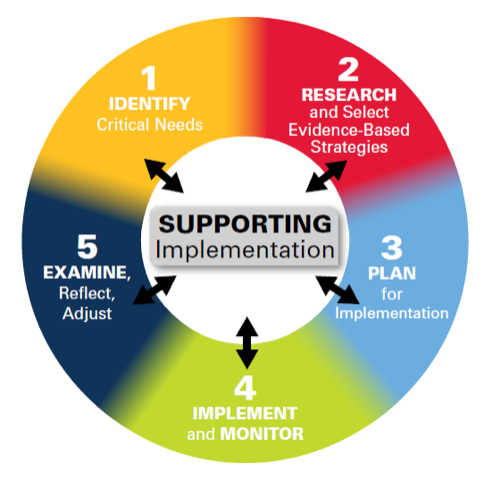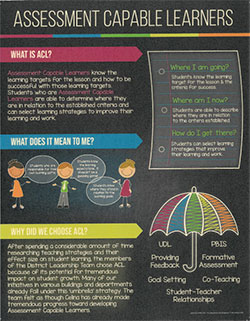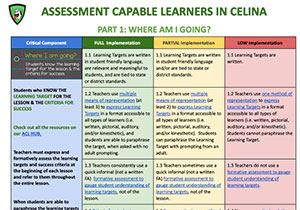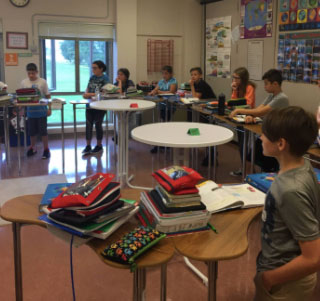Intentionality, Focused Support for Implementation Key to Improving Student Learning: Two Districts Share Their Stories

Ohio educators nominated three districts for the 2020 Ohio Leadership Advisory Council (OLAC) Outstanding District Award. This feature describes the work of two of the three districts – Caldwell Exempted Village (EV) Schools and Celina City Schools (recipient of the 2020 OLAC award). East Cleveland City Schools, the third nominee, was featured in the Winter 2020-2021 issue of Cornerstone Connections.
Districts nominated for the award must demonstrate implementation of Ohio’s Leadership Development Framework; use OLAC resources (e.g., online modules and tools) to support professional learning; and participate in and support regional or state professional development opportunities.
About the nominees. The Caldwell EV and Celina City school districts are federally classified as small town districts by the U.S. Department of Education’s in its Common Core of Data, a national database of all public elementary and secondary schools and school districts in the country. Both are also located in rural areas of the state – Caldwell EV in southeastern Noble County, and Celina City in Mercer County, located in west central Ohio on the Ohio-Indiana border.
Caldwell EV is a small district. It serves about 850 students in two school buildings – an elementary-middle school and a high school. Celina City Schools is larger and serves about 2,850 students across seven school buildings: the Education Complex, which serves children in Head Start; the primary building serving PK-Grade 2 students; the elementary school serving Grades 3-4 students; the intermediate school serving Grades 5-6 students; the middle school serving Grades 7-8 students; the high school serving students in Grades 9-12; and Tri Star Career Compact, a career technical center that serves students from Celina and eight other school districts.
Based on data reported on the 2018-19 Ohio Report Card, a little over 40% of the student population in both districts is classified by the state as economically disadvantaged. Fifteen percent of Caldwell’s student population is identified as eligible for services as a student with a disability as compared to 18% in Celina.
There are no children identified as English Learners in Caldwell EV; however, Celina serves a significant population of children (about 4% of its student body) who are of Marshallese descent, and about 1% of its students are identified as migrant. Mobility rates in Celina vary by population group from about 5% for children identified as Hispanic to over 24% for English Learners.
Both districts have committed to supporting adult implementation of effective instructional practices with the goal of improving learning outcomes for each child. Both make effective use of supports from the State Support Teams in their region and from OLAC.
Supporting Adult Implementation of Effective Practice
Attending to what the adults – the teachers, principals, related services personnel, central office personnel, and others – do across the district and supporting them to learn from each other and to learn as a system has been a focus of the improvement work in both Celina City and Caldwell EV.

In Celina, the district leadership rebranded the state’s improvement framework (i.e., the Ohio Improvement Process or OIP) as Celina’s Cycle of Improvement. This rebranding served to re-energize and re-engage staff in the process of improvement because, over the years, OIP had increasingly been viewed as more of a compliance activity by staff. “The OIP 5-step process was going well and then all of a sudden everybody’s saying, ‘you mean we’ve got to do this again?’” explained Dr. Ken Schmiesing, Superintendent of Celina City Schools. Refining and re-labeling the OIP helped staff “take more ownership of it at Celina, get us over the hurdle, and move forward again,” added Schmiesing.
The OIP as an improvement process (see graphic showing the five steps of the OIP) is intended for use by aligned collaborative learning teams at the district (the district leadership team or DLT), school (the building leadership teams or BLTs), and classroom (the teacher-based teams or TBTs).
Over the past several years, districts that have intentionally worked to increase the instructional capacity of teachers in content areas (e.g., literacy) have used DLT-BLT-TBT team structures to extend learning across the district and build the collective instructional capacity of the district to teach and support each child better. “We have TBTs, we have BLTs, and we have a DLT, but the use of the process has been a bit disjointed. We’re working to make it an embedded practice and building a system for how we look at data over time and get to the real function of the TBTs, BLTs, and DLT,” offered Kelli Wohlgamuth, Caldwell EV’s Curriculum & Testing Coordinator.

Caldwell EV is focusing on, among other things, how systematically to improve literacy instruction and literacy achievement for all children in the district. “Had it not been for COVID, we would have had teachers engage in LETRS professional development this year. We’ll be starting it next year,” explained Wohlgamuth. According to Wohlgamuth and Superintendent Kacey Cottrill, LETRS PD will bolster teacher knowledge and skill development begun through the Heggerty Phonemic Awareness Training provided by the district last year and support able to be provided through the district’s Striving Readers Grant.
Striving Readers grants are awarded to districts from the Ohio Department of Education for activities aligned with Ohio’s Plan to Raise Literacy Achievement. Districts use these grant funds to improve literacy outcomes for children, birth through grade 12, focusing especially on serving the greatest numbers of students living in poverty, students with disabilities, English learners, and students identified as having a reading disability.
Going to scale. Both Caldwell EV and Celina City are finding ways to improve learning opportunities and outcomes for all children by focusing on district-wide implementation of evidence-based practices. “We need to increase the scale of our effort and ensure our work is deep enough to affect practice. We need good data on the implementation of whatever we put in front of teachers who say, ‘engage me in something that will make me a better teacher and move my kids forward,’” observed Wohlgamuth.

In Celina City, district-wide use of an Assessment Capable Learner (ACL) framework is improving practice and moving kids forward. This framework teaches students meta-cognitive strategies that empower them to take control over their own learning. According to John Hattie, assessment capable learners are students who are able to assess their own learning, gauge when and where they need assistance, know where they’re going next in their learning, and know when they can move on with the understanding that they know where they are going next in their learning (Hattie, 2012). “To ensure that students become assessment capable, teachers must actively help students learn how to learn, in part by helping them select appropriate learning tools (strategies).” (Frey et al., 2018, p. 12).
Celina describes assessment capable learners (ACL) as students who know the learning targets for the lesson and how to be successful in reaching those learning targets. They can determine where they are in relation to established criteria and can select learning strategies to improve their learning and work.
“We started in the 2016-2017 school year doing the research, reading, working as a DLT, and looking at which practices we should adapt that would have the greatest impact on Celina and we kept coming back to ACL,” recalled Schmiesing.
Reducing fragmentation, organizing for coherence. ACL is used by Celina as a district-wide framework for supporting coherence in the delivery of instruction and the implementation of evidence-based practices across the district.
Schmiesing explains:
“ACL provides a framework. Instead of this school going in one direction, and another going in a different direction, it helps keep all the schools on that path with our DLT, BLTs, and TBTs. It creates a nice flow and makes all the staff members feel that they’re working together, that they’re in harmony, as opposed to having fragmented pieces of work.”
Celina also uses procedures based in Implementation Science to assess the degree of implementation of agreed-on actions in all classrooms in all schools across the district. “One thing Celina did that I think is really crucial to know and understand about their process is their use of Implementation Science in creating a practice profile,” explained Cherie Smith, a consultant from State Support Team (SST) Region 6, who works closely with Celina leadership. “The practice profile explains the critical pieces of the strategy, why it’s important, what it looks like, what it doesn’t look like, and what it looks like at different levels of implementation,” she added.

Schmiesing and Smith view the ACL framework as the umbrella that holds all other components of the district’s work – such as positive behavioral interventions and supports (PBIS), the use of formative assessment, universal design for learning (UDL), and co-teaching – together. An excerpt from the district’s ACL practice profile provides a description of what full, partial, and low implementation looks like at each critical component of the framework – from where am I going? to where am I now? to how do I get there?
To view the complete practice profile, see Assessment Capable Learners in Celina. Access videos showing Celina’s use of ACL in the classroom.
For additional information about developing assessment capable learners, see Missouri’s Educational Systems and Instruction for Learning (MOEDU-SAIL).
For more information about Implementation Science and to access implementation science tools and resources, see the NIRN and SISEP's Active Implementation Hub.
Clarity matters! Like Celina, leadership in the Caldwell EV School District is working to support greater clarity across the district in terms of learning targets and success criteria. “We’re participating in professional development focused on teacher clarity through a project where ODE has partnered with authors Doug Fisher and Nancy Frey. To me, it’s formative instructional practice in a different format and uses Hattie’s work on deconstructing standards; identifying learning targets, intentions, and success criteria; and developing aligned assessments,” said Wohlgamuth.
According to Cottrill and Wohlgamuth, the district’s participation in opportunities like the teacher clarity project is “equipping the administrative team to know what to look for and what to ask about during walkthroughs; to make expectations and non-negotiables clear; and to send the clear message that if the district wants to see particular practices being implemented, then district personnel will be looking at, measuring, and providing feedback to teachers and other educators about implementation of those practices.”
Wohlgamuth is spearheading the district’s work to align planning and implementation of focused activities through better data use:
“When I go back and look at the data over the past three years, I can see that in some areas, there are gaps across the board. That’s not just one teacher’s issue; it’s all teachers’ issue, and makes me want to get at the root cause. Is it that teachers don’t know how to teach conceptually? Is it the materials they’re using? Is it how we’re measuring what we’re doing? We need a better way to capture adult implementation data.”

Caldwell piloted the state’s One Needs Assessment, appreciates having a two-year period for planning and implementation, and takes seriously the development of the district improvement plan that is submitted through the Comprehensive Continuous Improvement Plan (CCIP). “I want what we put in the CCIP to be real, to be the real work we’re doing, and I want it to move the achievement “needle” for children. I truly believe you can move the needle if you know how to move the needle,” reflected Wohlgamuth.
Caldwell leadership is working with SST Region 12 on more effective data use to support instructional planning and implementation. District leaders are exploring OLAC resources that they can used to support implementation in key areas.
Fostering Shared Leadership on Behalf of Each Child
Celina City has participated in several professional learning opportunities that have supported its use of the ACL framework. District leadership has been strategic in selecting and participating in these opportunities, one of which has been the Ohio Leadership for Inclusion, Implementation, & Instructional Improvement (OLi4) project.
“We’ve had all of our principals participate in OLi4,” said Schmiesing. “OLi4 has helped principals look at that umbrella of all students, rather than looking at separating students, so they’re all able to discover their unique learning style and apply these skills to problem-solve, collaborate, and communicate. OLi4 has provided re-affirmation that we’re on the right path,” he added.
Smith added: “OLi4 reinforced the idea of collective teacher efficacy and sharing those mastery experiences through their teams. What Celina did was very smart; they made it possible for all principals to participate together in OLi4 so they would be able to talk about their new learning and work collaboratively to implement that new learning.”

OLi4 involves cohorts of principals and other leaders in a two-year professional development (PD) program that provides centralized PD, regional cadre meetings closer to home with participants from other districts, and in-school coaching. The focus of the PD is on supporting the effective use of inclusive instructional and organizational leadership practices that principals for leading teacher learning and promoting high-impact BLT and TBT meetings.
Inclusive instructional and organizational leadership practices – one of three major areas of practice supported through Ohio’s SST network – involves work to foster district-wide improvement, aligned with the OIP, in four major domains: (1) promoting system-wide learning, (2) prioritizing the improvement of teaching and learning, (3) building capacity through support and accountability, and (4) sustaining an open and collaborative culture. OLi4 is a project of the Columbus-based Systems Development & Improvement Center (SDI), a Center within the University of Cincinnati’s College of Education, Criminal Justice, and Human Services and is supported by the Ohio Department of Education. View more information about OLi4.

Celina engages in additional PD opportunities and activities – all connected to and subsumed within the ACL framework. Improving literacy outcomes for all children is a priority and Celina is aligning new reading materials with the science of reading and Ohio’s Plan to Raise Literacy Achievement. The district’s Innovative Strategies grant (awarded from ODE, Office for Exceptional Children) is helping Celina support the use of student-led individualized education program (IEP) meetings and identify more effective transition supports for students with disabilities.
The district is also intentional about engaging all aspects of the larger community in its work to improve learning opportunities and outcomes for all students. Community engagement involves a variety of activities, from working with the Ohio Migrant Education Center and Putnam County ESC to provide additional support to Marshallese families, supporting students transitioning from preschool to kindergarten, and bringing back the Future Farmers of America (FFA) program to the community.
“We are certainly in rural Ohio, so not having an FFA program was something that many of our farmers would tell us they just didn’t understand. The last time it was here was almost 20 years ago,” explained Schmiesing.
Celina understands the value of using OIP team structures – DLT, BLTs, TBTs – to support district-wide improvement. The DLT meets monthly and holds a longer meeting on a quarterly basis. BLTs meet at least monthly, and TBTs meet a couple times per month and, at the high school level, on a weekly basis.
“We invited our SST 6 consultant to be a more integral part of the DLT process and now have a local board member that participates on the DLT. One of the changes we made with our school schedule was to add seven two-hour delays, which provides more time BLT and TBT meetings and gives the teachers a greater amount of time to get together and work through the process,” states Schmiesing.
Schmiesing, who is a veteran school superintendent, credits Smith’s involvement in the district’s work with helping Celina align critical work and use it to improve adult and student learning. “When we get to a place where we are at a stumbling block, we need somebody from the outside looking in to give us information and more of a big-picture look.”
For Smith’s part, she believes Celina City Schools has been very smart in its approach to align and focus all of its work in order to improve adult and student learning, observing that “not all districts have a district-wide, systemic continuous improvement process.” That approach is enabling the district to make real its mission to challenge, prepare, and empower each student.
Resources
Frey, N., Hattie, J., & Fisher, D. (2018). Developing assessment-capable visible learners, grades K-12: Maximizing skill, will, and thrill. Corwin.
Hattie, J. (2012). Visible learning for teachers: Maximizing impact on learning. Routledge.
Ohio’s Plan to Raise Literacy Achievement (2020). Columbus, OH: Ohio Department of Education. Retrieved from https://education.ohio.gov/getattachment/Topics/Learning-in-Ohio/Literacy/Ohios-Plan-to-Raise-Literacy-Achievement.pdf.aspx?lang=en-US.